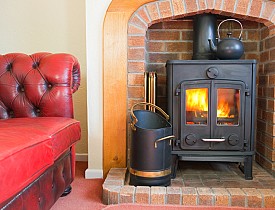How to Build a Hot Fire
 The key to using a wood stove efficiently is to build a hot fire. Isn't all fire hot? Yes, but not hot enough. Modern wood stoves can have burn efficiencies of 75 to 90% due to "secondary burns." A secondary burn is where the hydrocarbons in the smoke are re-ignited before leaving the stove, thereby reducing emissions and releasing more heat. For this to occur, a hot fire of 1000 –1200 degrees F is required. Hot fires also reduce the buildup of creosote in the stove and chimney pipe.
The key to using a wood stove efficiently is to build a hot fire. Isn't all fire hot? Yes, but not hot enough. Modern wood stoves can have burn efficiencies of 75 to 90% due to "secondary burns." A secondary burn is where the hydrocarbons in the smoke are re-ignited before leaving the stove, thereby reducing emissions and releasing more heat. For this to occur, a hot fire of 1000 –1200 degrees F is required. Hot fires also reduce the buildup of creosote in the stove and chimney pipe.
How Wood Burns
Rather than explaining advanced physics and principles of thermodynamics here, I'll share what I have learned from a lifetime of using wood stoves:
Contrary to what most people believe, the wood itself does not burn, but rather the combustible gases released from the wood when it is heated. If you watch closely, you'll see little "jets" of gas form on the ends of logs. These resemble minute blowtorches, and the heat from this burning gas releases more gas and keeps the fire going. The key to building a fire with plenty of combustible gas is to start it with ample kindling. Kindling is simply smaller bits of firewood, which allow more air contact and thus faster combustion. A good pile of kindling will get the stove heated quickly, and then allow larger logs to start burning faster.
Well-Seasoned Wood
Before wood will burn cleanly, the moisture needs to be removed (by drying) or driven off (by burning). If it's hissing or you can see bubbles forming on the log ends, your wood is not completely dry and its burning will be inefficient. This moisture and unburned "gas" can cause a smoky fire and lead to creosote build up. A lot of the beetle-kill firewood being harvested has been dead standing for some time and is pretty much ready to go. If you cut living timber, the rule of thumb is to season (dry) it for about a year prior to use. Obviously split wood will dry more quickly than "rounds," as more surface area is exposed to the air.
Preheating the Flue is Key to Preventing Creosote Accumulation
A fast hot fire will preheat the flue and reduce the chance of creosote accumulation. This preheating will also set the flue up to "draw" properly. Once airflow has been established in the flue, the intake ports on the stove will allow sufficient air to enter to burn more completely. The key to low creosote buildup is having chimney temperature well above boiling to keep the wood's moisture in the gas phase before it leaves the pipe. If the pipe is cold, these unburned gases, moisture and carbon products can condense on the inside of your flue.
Smoke and Coals
When a fire is first started, it will smoke, due to the combustion gases that have not yet reached combustion temperature. Sometimes you can watch this smoke "burst" into flames when it has become hot enough. On winter evenings, looking over my town, you can often see various plumes of smoke as people get their evening fires started. Once the fire's well established, there should be very little smoke, if any. If your fire is still smoking by the time your kindling's been used up, your firewood may be too wet, or your air supply too low. When starting a fire in a wood stove, fully open all vents or even leave the door ajar to allow the fire to burn with the most robust exposure to oxygen.
Timing Your Fire Right
In my big stove, the startup takes about 15 minutes. We like to use small bits of wood for the startup and then toss in the larger pieces. After 30 minutes or so, a coal bed starts to form and we close down the catalytic vent and set the intakes to about 50%. Once the stove is in this state, we can add large pieces every couple of hours. On really cold nights, or when the winds are cranking, we load up extra logs before bed. In the morning we can often resurrect a few coals and start all over again. Maintaining a shallow ash bed (about 2") actually allows for better fires. We clear out the ash after a few weeks' worth of fires. If your stove is running clean, the ash buildup should be minimal.
IMPORTANT: Remember to always place ashes in metal ash buckets, never in paper bags or plastic pails. Once or twice each year we read in the paper about a home fire due to improper ash storage. And hire a professional handyman to install a carbon monoxide alarm when you have a wood stove or any other fuel-burning appliance in the house.
Updated December 27, 2017.
Looking for a Pro? Call us (866) 441-6648

Heating & cooling Average Costs
HVAC Contractors Experiences

A Simple HVAC Repair Stopped Our Air Conditioner Blowing Hot Air

Urgent Air Conditioner Repair At Pizzeria Caught In A Heatwave



